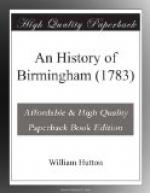This curious piece of architecture, the steeple of which is erected after the model of St. Paul’s, in London, but without its weight, does honour to the age that raised it, and to the place that contains it. Perhaps the eye of the critic cannot point out a fault, which the hand of the artist can mend: perhaps too, the attentive eye cannot survey this pile of building, without communicating to the mind a small degree of pleasure. If the materials are not proof against time, it is rather a misfortune to be lamented, than an error to be complained of, the country producing no better.
Yet, amidst all the excellencies we boast, I am sorry to charge this chief ornament with an evil which admits no cure, that of not ranging with its own coemetery, or the adjacent buildings: out of seven streets, with which it is connected, it lines with none.—Like Deritend chapel, of which I have already complained, from a strong attachment to a point of religion, or of the compass, it appears twisted out of its place. We may be delighted with a human figure, complete in stature, exactly moulded with symmetry, and set off with the graces of dress; but we should be disgusted, if his right side seemed to attempt to out-walk his left.
This defect, in religious architecture, arises from a strict adherence to the custom of the ancients, who fixed their altars towards the east. It is amasing, that even weakness itself, by long practice, becomes canonical; it gains credit by its age and its company. Hence, Sternhold and Hopkins, by being long bound up with scripture, acquired a kind of scripture authority.
The ground, originally, was part of a farm, and bore the name of the Horse-close; afterwards Barley-close.—Thus a benign spot of earth, gave additional spirits to a man when living, and kindly covered him in its bosom when dead.
This well chosen spot, is the summit of the highest eminence in Birmingham, with a descent every way; and, when the church was erected, there were not any buildings nearer than those in Bull-street.
The land was the gift of Robert Phillips, Esq; whence the name, ancestor to William Theodore Inge, Esquire.
In all degrees of people, from the bishop to the beadle, there seems a propensity in the mind to arrive at the honours of Sainthood: by joining our names in partnership with a faint, we share with him a red letter in the almanack.
Out of six churches in Birmingham, three bear the names of the donors. St. Bartholomew’s would, probably, have taken that of its founder, John Jennens, Esq; but that name happened to be anticipated by Sir John de Birmingham, who conferred it upon Deritend chapel. St. Mary’s could readily perpetuate the name of its benefactress, because we had no place of worship that bore it. But as neither the popish, nor the protestant kalendar produced a St. Charles, the founder of St. Paul’s was unfortunately excluded.
The gifts, which the benefactor himself believes are charitable, and expects the world to believe the same, if scrutinized, will be found to originate from various causes—counterfeits are apt to be offered in currency for sterling.




